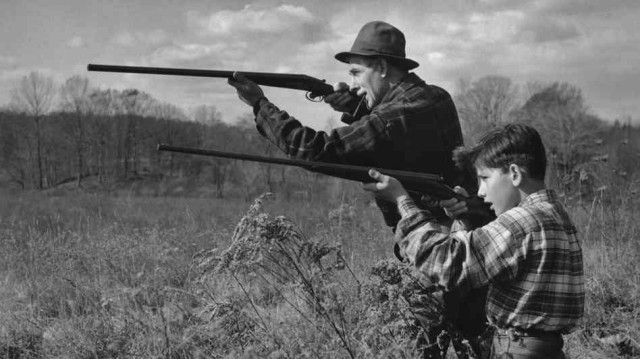Remembering When Gun Control Was at Least Remotely Rational

A curious mutation in gun control activism occurred during the last few decades, whence began a fixation on something dubbed the “assault rifle.”
Never mind that an assault rifle, insofar as the designation was ever at all valid, had always referenced a weapon with a “select fire” feature allowing three types of operation: semi-automatic, fully-automatic or in three-shot bursts. This doesn’t, of course, describe the class of rifles (e.g., AR-15-style) now targeted, whose operation is semi-automatic only (one bullet released per trigger pull), just like 50 percent of all new guns sold. But whatever you call them, here are two facts:
The obsession with banning them is much, much newer than they are.
They’re merely part of a weapons class (rifles) used in fewer killings than are “personal weapons” — hands, fists and feet. That’s according to the FBI, mind you.
In contrast, handguns are used in 62 percent of murders committed with firearms. There was a time when this guided gun-control activists’ thinking, too.
Back in the ’80s and into the ’90s, our rancorous firearms debates centered around banning handguns. I disagreed with such a course, but at least the gun-control set’s arguments contained a smidgen of logic.
These weapons are used to commit a robust plurality of our nation’s murders, they said.
They’re concealable and thus are criminals’ firearm of choice, they said. So if anyone believed in gun control as remedy, the focus on handguns at least made sense: Banning firearms would reduce crime, the thesis went, so it was rational to focus on the guns most used, by far, in crimes. It was today’s SJW’s grandfather’s gun control.
But those days now almost seem quaint. Emotion, which always figured prominently in gun-control appeals, has now completely taken over. No longer is there focus on handguns, not even a peep. Instead, it’s all Assault Weapons™ all the time. A couple of reasons for this leap to mind:
- High-profile mass shootings, which became a lamentably regular phenomenon starting in the ’90s, are often committed with semi-automatic sporting rifles such as the AR-15 (even though a semi-automatic shotgun would be far more effective in such a scenario; i.e., against soft targets at close range).
- They’re low-hanging fruit — Gun grabbers’ previous failures perhaps taught them that targeting handguns is currently in vain; pistols are the most commonly owned type of firearm, after all. So they focus on AR-15-type weapons.
This can be effective because
- laymen often find them scary, as they may look like sub-machine guns they see in movies. And as anti-Second Amendment activist Josh Sugarmann demagogically put it in 1989, “Assault weapons…are a new topic. The weapons’ menacing looks, coupled with the public’s confusion over fully-automatic machine guns versus semi-automatic assault weapons — anything that looks like a machine gun is assumed to be a machine gun — can only increase the chance of public support for restrictions on these weapons”;
- AR-15-type rifles are possessed by only a minority of gun owners, and with gun owners being just 32 percent of the country, this translates into their being in relatively few Americans’ hands. And people are more amenable to banning a product when doing so won’t affect them directly; and
- given how the weapons have been misrepresented, the argument “Why do you need such things, anyway?” can be persuasive.
As to the last point, one correct response is that if our freedoms are based on “needs,” we’ll have relatively few freedoms left. We don’t need a fast sports car, ice cream, opera, palatial homes, swimming pools (drowning is the most common cause of death in children 1-4), to go hang-gliding (one of the more dangerous sports) or a multitude of other things. This is why a freedom must be considered innocent until proven guilty; the burden must lie not with the person who’d retain it, but with the one who’d remove it.
Lastly, those who’d criminalize firearms generally believe the weapons are at best superfluous because they trust the government to protect them. That’s certainly a quaint idea. Remember the L.A. riots in 1992, when the government, constrained by political correctness, refused to quell the unrest and allowed miscreants to run amuck? Hapless truck driver Reginald Denny was beaten to within an inch of his life, and some of the only people we saw who could defend themselves were Korean store owners wielding firearms. There also was Hurricane Katrina in 2005, during which many police abandoned their posts and armed gangs were roaming about. Then, of course, there were 2020’s 600-plus BLM/Antifa riots, which also were allowed to proceed unfettered and destroyed billions in property and claimed at least two dozen lives.
But, hey, we’re sure that the next time the boogeymen come, the gubmint will be there for you, right?
Well, you just rest secure in that knowledge, Mr. Liberal, and may you, if worse comes to worst, rest in peace. I’ll just rest with a piece, thank you.
Contact Selwyn Duke, follow him on MeWe, Gettr or Parler, or log on to SelwynDuke.com
©Selwyn Duke. All rights reserved.


Govt will not protect us and police may get to you in minutes when seconds count with your self defense.
No self respecting soldier would carry a non-automatic weapon like an AR 15 into combat against an enemy armed with automatic weapons. The whole “assualt rifle” agrument by the left is ludicrous.
The left only wants criminals and law enforcement to possess guns which will make law enforcements job much harder.